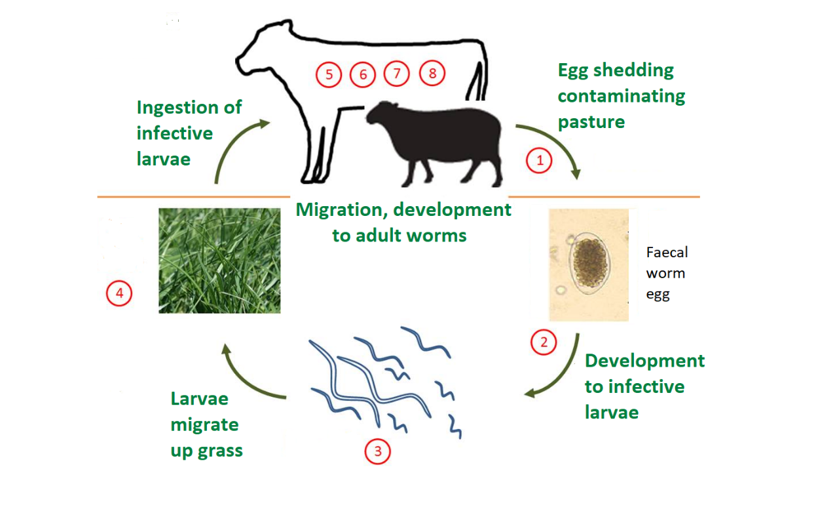Gastrointestinal Parasitism in Lifestyle Ruminants
Overview of life cycle
All grazing species of animal are infected by a variety of different gastrointestinal worms. It is normal for most grazing animals to have a low burden of worms resident in their gut. Different species of worms inhabit different parts of the gut, some like the stomach walls, while others are found more in the intestine.
Cooperia spp - Small intestine
Trichostrongylus spp – Small intestine
Nematodirus spp – Small intestine
Haemonchus contortus – Abomasum (stomach)
Teldorsagia circumcincta – Abomasum (stomach)
Adult worms inside the animal produce eggs which are passed out in the faeces onto the pasture.
The eggs develop into larvae which are infective to the animal.
The larvae are consumed by the animal when they eat the grass.
It takes around 21 - 28 days for the worm to develop from a larvae into an adult which will then produces more eggs.
Larvae develop under warm, humid conditions, hence why Autumn and Spring are considered the main risk periods. It is important to understand that the majority of worms are present on the pasture (larvae and eggs) rather than in the animal. Some larvae can survive for lengthy periods of times in the right conditions; normally around two - eight months, but studies have found that sometimes larvae can survive past a year! Infective larvae live in the bottom 2cm, therefore shorter grass and animals grazing lower to the ground are at a higher risk.
How do worms affect my animals?
Worms cause gut damage, which leads to an inability to absorb nutrients properly and protein leakage from the gut. Animals can have diarrhoea and lose condition despite being fed well.
Animals may lose condition / be poor growers, look unwell / lethargic, have diarrhoea (scours), or have no signs at all.
Young stock are more at risk from clinical cases of parasitism. Sheep and cattle develop some immunity to worms by 15 - 18 months of age and are generally less affected. Camelids (llamas and alpacas) and especially goats do not develop as strong an immunity and often have problems as adults.
The barbers pole worm (Haemonchus contortus) is a little different, it not only damages the stomach lining, but also sucks blood from the damaged area. With small numbers, this is not a problem, but in large numbers can lead to anaemia and death. Often the only way to save a sick, anaemic animal is a blood transfusion.
How can I test for worm burdens in my animals?
A faecal egg count (FEC) test is an easy and effective way to determine worm burdens in an animal.
This entails taking a fresh faeces sample from each animal, labelling it and bringing it into the clinic.
We will then prepare and look at a sample under the microscope to determine how many worm eggs per gram of faeces are present.
How can I manage worms on my property?
Drenching
Create a plan and stick to it! The best way to create a plan that works with you is to conduct several FEC tests and talk to your veterinarian.
Every property and every flock/mob is different! This is important to remember when creating your plan. Some people will need to drench every four weeks, while some others may manage for months! The frequency at which you will need to drench depends on lots of factors.
Create a plan and stick to it!
Start a basic plan by conducting several FWEC tests every four to eight weeks to determine the current burden of parasites in your animals. If the burden is too high then we will recommend you drench your stock.
Once we have done a few tests we can get a rough idea of what the burden is like on your property and can revise your plan to be more accurate for the future.
If you have young stock you should be drenching them every four to six weeks throughout their first Spring and Summer regardless. Drenching too often however, can lead to problems, so discuss the best method for you with our vets.
- the basis for this preventative drenching is that the pasture when being grazed by young animals, can be infected with a high burden of eggs and larvae, so animals can be reinfected in 21 – 28 days’ time.
Drenches come in oral, injectable and pour on preparations. This is the general order in their effectiveness, but we always consider ease of administration and handler safety which may lead us to use a pour on or injectable product. Please discuss with your vet which drench is best for you and your animals.
GRAZING MANAGEMENT
This another way to reduce parasitism. Rotating stock around different paddocks, having several different kinds of stock and not grazing too low helps keep parasitism down as well. If you don’t have numerous paddocks to move stock too, simply ‘poo picking’ the paddock is also an easy way to help reduce the burden.
All stock have a natural balance of nutrition versus parasitism i.e. it is normal to have a small worm burden in healthy individuals. An animal’s nutritional status helps determine how able it is to keep this balance, as well as be resistant to any other kind of disease.
Key Points Summary
• Young animals are more at risk!
• Make a plan and stick to it! Consult us for more information about a plan for you.
• The majority of the worm burden lives in the pasture!
• There are many ways at reducing the impact of worms on your animals (not just drenching).








